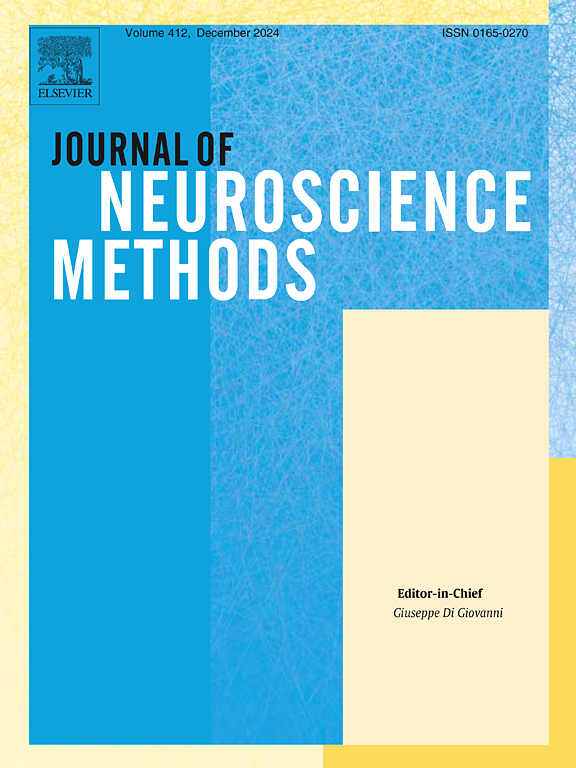Detecting fast-ripples on both micro- and macro-electrodes in epilepsy: A wavelet-based CNN detector
IF 2.7
4区 医学
Q2 BIOCHEMICAL RESEARCH METHODS
引用次数: 0
Abstract
Background
Fast-ripples (FR) are short (∼10 ms) high-frequency oscillations (HFO) between 200 and 600 Hz that are helpful in epilepsy to identify the epileptogenic zone. Our aim is to propose a new method to detect FR that had to be efficient for intracerebral EEG (iEEG) recorded from both usual clinical macro-contacts (millimeter scale) and microwires (micrometer scale).
New Method
Step 1 of the detection method is based on a convolutional neural network (CNN) trained using a large database of > 11,000 FR recorded from the iEEG of 38 patients with epilepsy from both macro-contacts and microwires. The FR and non-FR events were fed to the CNN as normalized time-frequency maps. Step 2 is based on feature-based control techniques in order to reject false positives. In step 3, the human is reinstated in the decision-making process for final validation using a graphical user interface.
Results
WALFRID achieved high performance on the realistically simulated data with sensitivity up to 99.95 % and precision up to 96.51 %. The detector was able to adapt to both macro and micro-EEG recordings. The real data was used without any pre-processing step such as artefact rejection. The precision of the automatic detection was of 57.5. Step 3 helped eliminating remaining false positives in a few minutes per subject.
Comparison with Existing Methods
WALFRID performed as well or better than 6 other existing methods.
Conclusion
Since WALFRID was created to mimic the work-up of the neurologist, clinicians can easily use, understand, interpret and, if necessary, correct the output.
检测癫痫微电极和大电极上的快速损伤:基于小波的 CNN 检测器。
背景:快速波纹(FR)是200-600Hz之间的短(~ 10ms)高频振荡(HFO),有助于癫痫患者识别癫痫区。我们的目的是提出一种新的检测FR的方法,这种方法必须对从通常的临床宏观接触(毫米尺度)和微线(微米尺度)记录的脑内脑电图(iEEG)有效。新方法:该检测方法的第1步基于卷积神经网络(CNN),该网络使用从38例癫痫患者的宏观接触和微线的iEEG记录的bbbb11000 FR的大型数据库进行训练。FR和非FR事件作为归一化时频图馈送到CNN。步骤2是基于特征的控制技术,以拒绝误报。在步骤3中,使用图形用户界面将人恢复到最终验证的决策过程中。结果:WALFRID在真实模拟数据上表现优异,灵敏度达99.95%,精度达96.51%。该检测器能够适应宏观和微观脑电图记录。真实数据被使用,没有任何预处理步骤,如伪影剔除。自动检测精度为57.5。步骤3有助于在几分钟内消除每个受试者的假阳性。与现有方法的比较:WALFRID与其他6种现有方法的疗效相同或更好。结论:由于WALFRID是为了模仿神经科医生的工作而创建的,临床医生可以很容易地使用、理解、解释,并在必要时纠正输出。
本文章由计算机程序翻译,如有差异,请以英文原文为准。
求助全文
约1分钟内获得全文
求助全文
来源期刊

Journal of Neuroscience Methods
医学-神经科学
CiteScore
7.10
自引率
3.30%
发文量
226
审稿时长
52 days
期刊介绍:
The Journal of Neuroscience Methods publishes papers that describe new methods that are specifically for neuroscience research conducted in invertebrates, vertebrates or in man. Major methodological improvements or important refinements of established neuroscience methods are also considered for publication. The Journal''s Scope includes all aspects of contemporary neuroscience research, including anatomical, behavioural, biochemical, cellular, computational, molecular, invasive and non-invasive imaging, optogenetic, and physiological research investigations.
 求助内容:
求助内容: 应助结果提醒方式:
应助结果提醒方式:


